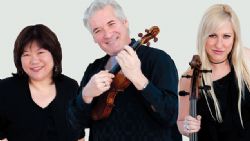|
Symphony
MONUMENTAL MAHLER 5TH IN SO CO PHIL'S SEASON ENDING CONCERT
by Terry McNeill
Sunday, April 14, 2024
Chamber
OAKMONT SEASON CLOSES WITH STRAUSS' PASSIONATE SONATA
by Terry McNeill
Thursday, April 11, 2024
Chamber
MORE GOLD THAN KORN AT ALEXANDER SQ CONCERT
by Terry McNeill
Sunday, April 7, 2024
Choral and Vocal
VIBRANT GOOD FRIDAY REQUIEM AT CHURCH OF THE ROSES
by Pamela Hicks Gailey
Friday, March 29, 2024
TWO OLD, TWO NEW AT THE SR SYMPHONY'S MARCH CONCERT IN WEILL
by Peter Lert
Saturday, March 23, 2024
Chamber
NOT A SEVENTH BUT A FIRST AT SPRING LAKE VILLAGE CONCERT
by Terry McNeill
Wednesday, March 20, 2024
THIRTY-THREE PLUS VARIATIONS AND AN OCEAN VIEW
by Terry McNeill
Saturday, March 16, 2024
Choral and Vocal
A ST. JOHN PASSION FOR THE AGES
by Abby Wasserman
Friday, March 8, 2024
Choral and Vocal
SPLENDID SCHUBERT SONGS IN SANET ALLEN RECITAL
by Terry McNeill
Saturday, March 2, 2024
Chamber
SHAW'S MICROFICTIONS HIGHLIGHTS MIRO QUARTET'S SEBASTOPOL CONCERT
by Peter Lert
Friday, March 1, 2024
|
 |
 Zuckerman Trio |
MUSIC AND ART MELD IN ZUCKERMAN TRIO CONCERT
by Nicki Bell
Friday, February 24, 2017
A Feb. 24 Weill Hall concert by the Pinchas Zuckerman Trio juxtaposed formidable music making with palpable associations about visual art.
Brahms’ C Minor "Sonatensatz” (Scherzo) is a short youthful work for violin and piano, and was an opening call to action. Lively and vigorous playing alternated with the tender and gentle, and pianist Angela Cheng and Mr. Zuckerman mastered the quickly shifting rhythms of the five-minute piece, originally a movement in a collaborative sonata. It was over in a flash.
Most of the first half of the program was Kodaly's remarkable Duo for Violin and Cello, Op. 7.
Ms. Forsyth and Mr. Zuckerman are a striking stage couple. Like his fellow
Hungarian Bartok, Kodaly's music is filled with references to Hungarian folk and gypsy rhythms and tunes. Written in 1914, the large-scale work in three movements gave each instrument a full range of expression and
technical virtuosity. The allegro serioso was very dramatic with bursts of power, tempo changes and motifs passed back and forth. It ended in a whisper. A lovely searching and ruminating cello solo launched the adagio,
then bursts of Magyar character.
The improvisatory opening of the finale leaps into a propulsive presto that quotes a Hungarian children's song. Mr. Zukerman has a mastery of violin tone color and the ability to make
a single sustained note become eternity. It was difficult to believe there were only two instruments playing and not a small orchestra creating this world of sweeping passion with orchestra affects.
Schubert's B Flat Trio (Op. 99, D. 898) brought all three musicians together, and as a trio they have been together since 2013. The shifting balances of the instruments
throughout the whole trio were beautifully crafted, and modulations were underscored and phrases balanced. The Zuckerman Trio captured the character of the music, written during Schubert’s last year, in every changing moment. Ms. Cheng joined the mix with with a sensitive touch and clear articulation. It was a three-way conversation: the luscious cello tone, the piano support and the warmth of the violin line. The playing had sparkle and easily reminded one of the “Trout” Quintet and much of the composer’s song output.
The first movement was full of yearning and joy and color. Ms. Forsyth’s warm cello sound was captivating in the andante, and the ensemble became a lullaby with Mr. Zuckerman’s rich violin tone and Ms. Cheng’s softly rocking piano line. One of the great slow movements of all classical music, this movement alone could seduce one to embrace Schubert. In the frolicking scherzo the playing was effervescent.
The performance of the finale was a joy to hear and the Trio traded off themes and phrases in a light-hearted manner. This was music with an artistic smile after each artistic frown.
Robert Schumann said "One glance at the Schubert Op. 99 Trio and the troubles of our human existence disappear
and all the world is fresh and bright again." This exemplary performance proved the comment.
Prior to the concert a reception in Weill’s lobby was held to inaugurate the hanging of a painting, “The Tower,” by Sonoma State artist Mark Perlman. Situated behind the lobby bar, the work was described as embodying the close relationship of fine art and music.
Sonia Tubridy contributed to this review.
|
